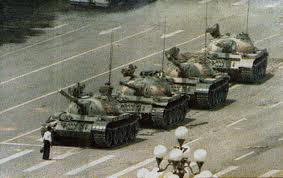
 Starting on April 15, 1989, protests sparked by mass mourning over the death of CPC General Secretary Hu Yaobang, a Party official purged for his political liberalization and coinciding with the collapse of a number of communist governments in Europe, brought non-violent civil resistance to China as a direct confrontation with the Communist government. Martial law was declared on May 20, but it wasn’t until June 4 that military action was taken. Tanks and troops rolled into the streets of Beijing using live fire. Estimates vary from hundreds to thousands of protesters killed in the subsequent crackdown.
Starting on April 15, 1989, protests sparked by mass mourning over the death of CPC General Secretary Hu Yaobang, a Party official purged for his political liberalization and coinciding with the collapse of a number of communist governments in Europe, brought non-violent civil resistance to China as a direct confrontation with the Communist government. Martial law was declared on May 20, but it wasn’t until June 4 that military action was taken. Tanks and troops rolled into the streets of Beijing using live fire. Estimates vary from hundreds to thousands of protesters killed in the subsequent crackdown.
Gatherings for human rights are taking place in various locales around the world. The Wall Street Journal is reporting that around 150,000 people attended a rally in Hong Kong. Hong Kong, a special administrative region of China with its own laws, has apparently held a June 4 commemoration every year since 1989. WSJ states that such activities are illegal on the mainland.
Reuters writes that the U.S. and Taiwan press China to release dissidents and fully address the bloody crackdown on pro-democracy demonstrations around Tiananmen Square 22 years ago, as China tightens the noose on rights activists. They say that there are still five dissidents in jail for their participation in the 1989 protests.
The Vancouver Sun points out that the Chinese government continues to hold tight control over its people. Only a few days ago, the party secretary of Inner Mongolia declared martial in a pre-emptive strike against ethnic Mongols protesting the killing of their brethren by Han Chinese. When Beijing became apprehensive earlier this year that China would be infected by the spirit of the Jasmine Revolutions sweeping the Middle East, authorities began detaining scores of people without any legal process and in defiance of the country’s own constitution. The message that the Communist party took from those events 22 years ago was that it must squash any group that looks as though it might become a national organization. Any events or figures who might become an umbrella or rallying point for unrest and dissent are to be eradicated immediately. This strategy has been largely successful.
The Sun goes on to point out that the same abuses of power and endemic corruption which sparked the Tiananmen protests of 1989 exist today and the question is whether or not those protests or protests like those of the Middle East may one day return to China in an attempt to dramatically upset the status quo so desperately maintained by the current government. As the middle class grows, as the country gets richer, sooner or later people are going to demand their fair share and inevitably, the government will have comply. The next question, with an eye on Yemen, Syria, and Libya, is just how many people will die in overthrowing the status quo.
References
Wikipedia: Tiananmen Square protests of 1989
http://en.wikipedia.org/wiki/Tiananmen_Square_protests_of_1989
The Tiananmen Square protests of 1989, also known as the Tiananmen Square massacre and the June Fourth Incident (in part to avoid confusion with two prior Tiananmen Square protests), were a series of demonstrations in and near Tiananmen Square in Beijing in the People’s Republic of China (PRC) beginning on 15 April 1989. The movement used mainly non-violent methods and can be considered a case of civil resistance. Led mainly by students and intellectuals, the protests occurred in the year that was to see the collapse of a number of communist governments in eastern Europe.
The protests were sparked by mass mourning over the death of former CPC General Secretary Hu Yaobang, a Party official who had been purged for his support of political liberalization. By the eve of Hu’s funeral, 100,000 people gathered at Tiananmen Square. Beijing students began the demonstrations to encourage continued economic reform and liberalization, and evolved into a mass movement for political reform. From Tiananmen Square they later expanded to the surrounding streets. Non-violent protests also occurred in cities throughout China, including Shanghai and Wuhan. Looting and rioting occurred in various locations throughout China, including Xi’an and Changsha.
The movement lasted seven weeks after Hu’s death on 15 April. Premier Li Peng, a hardline conservative, declared martial law on May 20, but no military action took place until June 4, when the tanks and troops of the People’s Liberation Army moved into the streets of Beijing, using live fire while proceeding to Tiananmen Square to clear the area of protestors. The exact number of civilian deaths is not known, and the majority of estimates range from several hundred to thousands. There was widespread international condemnation of the government’s use of force against the protesters.
Following June 4, the government conducted widespread arrests of protesters and their supporters, cracked down on other protests around China, banned the foreign press from the country and strictly controlled coverage of the events in the domestic press. The Communist Party initiated a large-scale campaign to purge officials deemed sympathetic to the protests. Several senior officials, most notably Party General Secretary Zhao Ziyang, were placed under house arrest.
Click HERE to read more from William Belle
Article viewed at: Oye! Times at www.oyetimes.com

Be the first to comment